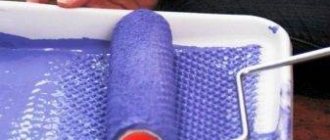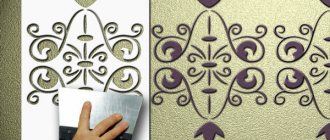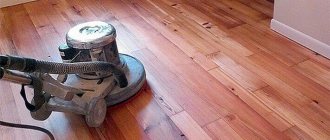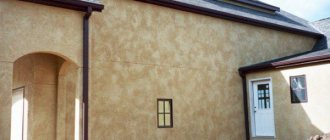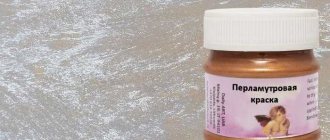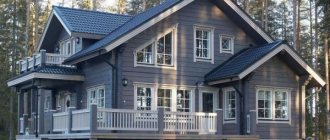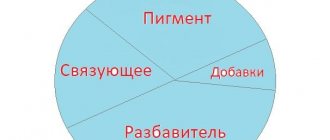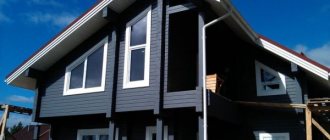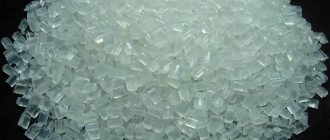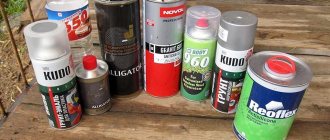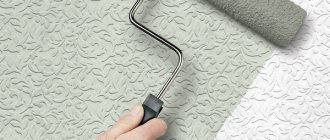Facade paint allows you to quickly and inexpensively refresh the appearance of a building. A popular variety is acrylic paint for exterior use, which has gained recognition due to its practicality and good performance characteristics.
Facade acrylic paints, after drying, form a thin polymer layer that protects the facade from the negative effects of the environment.
Features of facade acrylic paint
Before you paint walls with such compounds, you need to understand what they are. Acrylic paints are made on the basis of appropriate resins. Water is most often used as a solvent, although organic-based varieties are also found.
Theoretically, latex mixtures are also included in this group, since they are acrylic materials, only the composition includes artificial rubber, and the amount of resins is increased. Acrylic mixtures form an elastic, airtight, abrasion-resistant coating.
The advantage of acrylic paint is its versatility. It is used for almost all substrates, except lime plaster and sand-lime brick. This means that it is applied to ceramic bricks, mineral plaster, wood, etc.
At the same time, acrylic compositions are good for old facades, as they help strengthen the base.
Mixtures are recommended for painting walls and ceilings inside a building, but in this case we are talking about an interior variety, which is especially valued for its environmental friendliness.
Acrylic resin is the basis for most façade acrylic paints.
The composition of acrylic paint includes the following components:
- The binder is acrylic resins, which allow the formation of a durable film coating. Acrylic mixture and acrylate, despite similar names, differ in the binder, since the first contains an acrylate-copolymer dispersion with vinyl, latex or styrene, and the second contains resins in their pure form.
- Fillers that are necessary to improve performance (for example, increase the level of water resistance, add a glossy shine or provide a matte texture).
- Auxiliary substances, including various thickeners, stabilizers, defoamers.
Compositions may vary from manufacturer to manufacturer. In addition, within 1 line they produce mixtures that differ in characteristics and purpose.
Components
The composition of acrylic dye is divided into components:
- coloring colors;
- The binder component is a polymer dispersion, which is obtained from acrylic resins. The functional purpose is the adhesion of the CM to the facing surface and the connection of all elements with each other. Responsible for resistance to mechanical loads and durability of the coating;
- solvents;
- additives;
- fillers increase the viscosity of the dye and are responsible for protective functions.
The quality of the CM depends on the type of acrylic resin. If necessary, a solvent reduces the viscosity of the product. To strengthen the protective layer of the dye, varnish is applied over it. Many manufacturers have already included it in the CM.
We recommend videos on the topic:
Advantages and disadvantages
Water-dispersed acrylic mixture has the following advantages:
- upon polymerization, it forms a thin, durable, elastic coating that is resistant to abrasion;
- has a low water absorption rate, which allows you to protect the base material from the negative effects of moisture;
- Available in a wide range of colors;
- easily diluted with water or alcohol;
- forms a coating that can withstand frost;
- dries quickly, which reduces the time required to complete the work;
- has vapor permeability, due to which the material “breathes”;
- retains original color for a long time.
Acrylic paint is used both to protect concrete facades in apartment buildings and to treat the facades of low-rise wooden buildings.
Acrylic paint has disadvantages:
- High price compared to other types of compounds.
- Caution is required when using this type of mixture. The paint layer is applied, after which a break is taken, since there is a risk that it will not dry enough and the paint will not adhere as well. You should wait until it dries completely to understand how necessary another layer is.
You should only buy products from popular manufacturers. Low-quality mixtures can change their shade, even during the drying process.
Technology for painting wood and other surfaces
Depending on the type of surface, the painting technology may differ slightly. Therefore, it is important to consider the material from which the facade is made.
For metal surfaces, paint with an anti-corrosion effect is selected to avoid negative consequences in the future. This will extend the life of the coating. Before painting, be sure to remove traces of rust.
For metal surfaces, select paint with an anti-corrosion effect.
The brick base is more difficult to paint. It is first removed from cracks and defects. Cement or plaster is suitable for this. Then the surface is primed. For painting, it is recommended to use a wide brush, which allows you to apply the paint without unpainted stripes.
For painting, it is recommended to use a wide brush, which allows you to apply the paint without unpainted stripes.
Concrete and plastered surfaces lend themselves well to painting. You just need to prime everything first.
Concrete and plastered surfaces lend themselves well to painting.
The facade painting technology consists of the following steps:
- Surface preparation. It is recommended to remove the old cladding, remove defects and prime the entire work area.
- It is recommended to protect objects and surfaces on which paint may come into contact. You can cover them with polyethylene.
- Apply the first coat of paint. It is considered basic. You can use any convenient tool. For difficult places it is worth using a brush. They move from top to bottom.
- Subsequent layers are applied only after the previous ones have dried. Painting is carried out so that there are no unpainted areas left on one plane.
When all layers have been applied, all that remains is to wait for the paintwork to dry completely. For coloring, it is better to choose dry, warm weather with a temperature of at least +5 degrees. Humid or hot conditions are not suitable and will only negatively affect the work, appearance of the facade and the life of the paint.
Painting is carried out so that there are no unpainted areas left on one plane.
Scope and types of paint
This is an all-season paint that withstands temperature changes and adverse environmental conditions, which has provided a wide range of applications.
The mixture can be applied to any mineral base; it can also be used on wood. Concrete, brick, textured, cement or acrylic plaster are suitable options. Wooden facades, gazebos, and terraces can also be painted with acrylic compounds.
It is believed that it can also be used for metal parts, although this is not the best option for them. It fits worse on acrylic plaster and sand-lime brick, as well as on old coating if it is formed by silicate materials.
In this case, the mixtures allow you to obtain any shades by adding pigment. The material must be diluted and tinted in accordance with the manufacturer's instructions.
Manufacturer's choice
The Russian market offers a wide selection of materials based on acrylic resin. You can find products from foreign and domestic manufacturers. Among the most popular acrylic-based paints are:
- Facade paint "Lakra". It is suitable for use on balconies, building facades, public spaces and places with high humidity. The paint forms a matte white finish. These compounds combine high technical characteristics with excellent appearance.
- Composition "Ceresit". Used for painting facades on plaster. It is applied to mineral and finishing plasters. The product has high wear resistance and low water absorption. It is characterized by high wear resistance.
- Paint "Halo". It has a wide range of uses and can be applied to surfaces made of brick, concrete, wood, cement and plaster. Has colors to create a variety of shades.
- Oil paint "Tikkurila". It is considered an excellent option for substrates that have previously been painted. It is not suitable for application over silicate, lime and elastic coatings. The paint is ideal for mineral substrates.
- Product "Akrial Lux". Created specifically for regions with extreme weather conditions. It can be used even at sub-zero temperatures. The basis can be concrete, cement and all types of plaster.
To obtain a high-quality result, you should choose not only a well-known manufacturer, but also good quality paint, which has been stored taking into account all the necessary requirements . The technical features of the composition and the surface for its application should be taken into account. It is also important to properly prepare the surface before using the material.
Specifications
There are a number of characteristics that are important for external work. They may differ from one manufacturer to another, so you should check all the parameters using the accompanying documentation.
These characteristics include:
- Vapor permeability, that is, the ability to pass steam, preventing the formation of condensation and improving the operating conditions of wall and thermal insulation materials. Some manufacturers indicate the amount of water that penetrates a painted surface of 1 square meter. In this case, the indicator should be no lower than 120 g/sq.m per day. If the coefficient of diffuse properties is specified, it is designated as Sd. Normal vapor permeability in this case is 0.05-0.11 m.
- Water permeability is also considered an important parameter. For facade paint, it is important that the indicator is at a minimum level, otherwise the walls will be damp, fungi and mold may appear on them, and the layer will collapse before plaster. In technical documentation, the indicator is called the water absorption coefficient and is denoted as w. It should be no more than 0.03-0.05 kg/sq.m*h, but the lower the better.
- Resistance to ultraviolet radiation. Sunlight is useful because it prevents the appearance of mildew and mold, but it can destroy even high-quality paint pigments, and sometimes the rays cause the layer to swell or crack. Acrylic compounds have high UV resistance.
- Abrasion resistance. From the outside, the walls of the house become dirty even during normal use; they need to be cleaned periodically, otherwise the paint and plaster layers will be destroyed. This is why abrasion resistance is so important. Manufacturers determine it in laboratory conditions. It reflects the number of cleaning cycles that the coating can withstand. A good indicator is at least 5000 cycles.
- Drying time. Typically, acrylic paint dries within 24 hours, but under favorable conditions this happens even faster, which is important for façade mixtures.
Paint consumption plays an important role. The financial costs of finishing work also depend on it. Acrylic mixture is more expensive than other facade compositions.
24 hours is the time required for most types of façade paints to dry completely.
Advantages of acrylic dye
The protective film on the facade after applying the acrylic composition consists of polymers. Acrylic facade paint combines well with the wall of the house construction. A strong protective cover is formed from harmful factors.
Acrylic CM has a number of advantages that made it popular:
- ability to withstand increased moisture accumulation;
- resistance to high temperatures;
- the material does not lose its quality for a long time (20 years);
- mechanical loads are maintained;
- interaction with chemicals;
- easy to apply, quick drying;
- safety due to the absence of a pungent odor;
- a wide palette of colors, the ability to choose pigments.
Sometimes it happens that applying acrylic CM is the only possible option for decorating the surface. Thus, the purity of the constituent components in the raw material allows it to be used in children’s rooms and in houses where allergy sufferers live.
Useful video on the topic:
For facade work
The mixture for outdoor use from different manufacturers has different characteristics, so it would be advisable to indicate average values. So, on average, the service life of such coating is 7 years.
The drying time of 1 layer on a mineral base is from 30 minutes to 2 hours. Afterwards, you can dilute a new portion of paint and apply the 2nd layer. But complete drying takes longer - up to 24 hours.
As for the artistic effect, acrylic paints can be different, from a deep matte texture to a silky glossy sheen.
The water absorption coefficient of most compositions does not exceed 0.03 kg/sq.m per hour. The average density is 1.3-1.42 kg/l. The operating temperature range of the finished layer is -50…+70°C. In this case, the application temperature varies widely (-20…+30°C).
Staining algorithm
If the preparatory work has been completed and the primer mixture has been applied, then the stage of applying acrylic facade paint begins. The permissible operating temperature is not lower than +5°C, humidity is not more than 40%. If the dye was stored at temperatures down to -20°C, then before application it is warmed to the air temperature inside the room. It is not recommended to purchase CM that has been stored outdoors all winter.
The facade is painted in accordance with the recommendations:
- The hand movement is performed from top to bottom, this is how the CM layer begins to be applied.
- Wait at least 3 hours, maximum 12 hours until the layer dries.
- The second layer is applied with a short-nap roller. This will reduce dye consumption.
- Use a brush to paint areas where you cannot use a roller, as well as corners.
- The second coat will be dry after 24 hours.
It is necessary to organize ventilation of the room during the painting stage.
Interesting video on the topic:
For wooden facades
Universal facade acrylic paint from GOL.
For wooden surfaces, materials with the same characteristics are used as for standard facade work.
But you should pay attention to the fact that to improve adhesion in this case you need to use a primer, preferably acrylic.
At the same time, on a wooden surface, such paints dry longer than indicated - up to 6-8 hours.
Polyvinyl acetate paint
Water-based paint of this type is used not only for interior but also for exterior decoration. In addition, the material can be used for processing wooden surfaces, cardboard, plywood and so on. This material is fireproof; prolonged exposure to water can lead to damage to the coating. Drying time at optimal temperature and humidity is 2 hours. The covering power of the material is high, but to cover stains and darker tones you will have to apply 2-3 layers. The material consumption is 200 ml per 1 m2. Due to its relatively high consumption, this material is one of the most expensive in the water-based class.
Polyvinyl acetate paints have an optimal price-quality ratio
When choosing a material, it is important to remember that all the above technical characteristics are inherent only in compositions that are manufactured using the correct technologies. They have nothing to do with handicraft materials
